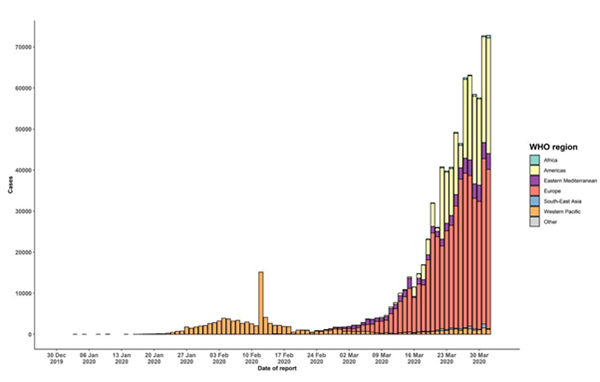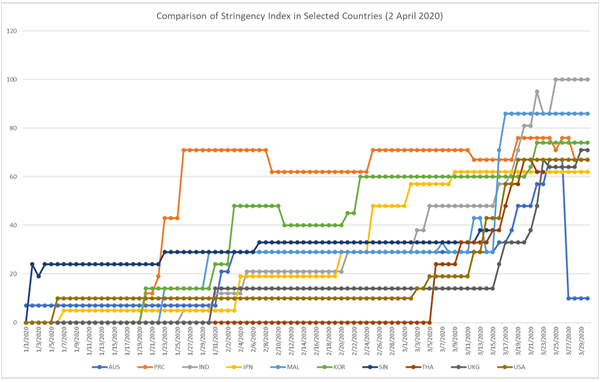
Trends and impacts of the pandemic
The COVID-19 pandemic has quickly become a severe global crisis, with a drastic spread in less than 2 months and shifts in its epicenter. Almost 1 million people have been infected with the virus around the world, and the number of deaths has shot up rapidly and continues to grow. Although the fatality rate is comparative low, COVID-19’s infection rate is uniquely higher and has spread faster than other deadly viruses, such as SARS, Ebola, and MERS. As of 2 April, the World Health Organization (WHO) has reported 896,450 confirmed cases in 206 countries, areas, and territories around the world, of which there have been 45,693 deaths. The biggest proportion has now shifted from the People’s Republic of China to the United States (US) and Europe, where infection rates have been accelerating remarkably since mid-March.
Figure 1: Epidemic curve of confirmed COVID-19 cases, by date of report and WHO region (as of 2 April 2020)

Source: WHO (2020).
The fast spread of COVID-19 has brought serious concerns to global governments and citizens around the world. To slow the spread and prevent transmission, many countries have inevitably had to shut down their borders and impose temporary travel bans and lockdowns. These lockdowns and bans have stopped economic activities worldwide through many channels and sectors, such as tourism, air travel, hospitality sectors, retail and wholesale trade, and SMEs, eroding market confidence and creating economic uncertainties.
Sharp contractions in output levels will soon be witnessed along with declines in household spending, corporate investment, and international trade. Consequently, global supply chains are being disrupted while the spillovers of weak demand are rising through trade and production linkages. Stock markets are the first to react through volatilities in stock prices across the world, while the most vulnerable groups could be small firms and both formal and informal workers who rely on daily income and have no social security or welfare.
The Asian Development Bank (ADB) (2020a) forecasts the global economic impacts to be in the range of $2 trillion–$4.1 trillion, equivalent to between 2.3% and 4.8% of global GDP, with the magnitude of the impacts depending on how the outbreak evolves. Developing economies in Asia will be hit hard due to the major economic impacts on the People’s Republic of China (ADB 2020b).
Global responses and stimulus packages
With its adverse economic impacts, the COVID-19 pandemic has prompted global responses from international organizations and governments around the world. Restoring economic normality and social stability will require certain policy actions to be implemented spontaneously. Mobilizing the macroeconomic levers of fiscal, monetary, and stability policies is essential along with cooperation among international organizations and timely and coordinated responses by governments (OECD 2020b).
Among the immediate responses, governments in many countries have announced and implemented fiscal stimulus and emergency measures to help the most affected people and businesses. After skyrocketing numbers of infected people in the country, the US Congress passed an emergency spending bill under the Coronavirus Response Act, worth approximately $2 trillion. The fiscal measures provide income support and insurance payments as well as other financial support to households and individuals. The financial support also extends to companies by providing capital, liquidity, and business loans and grants for SMEs and struggling businesses hit by the coronavirus, together with tax reductions and deferrals. Targeting similar groups and measures, a stimulus package of £401.5 billion was announced by the Government of the United Kingdom to counter the impacts of COVID-19, in addition to the Coronavirus Job Retention Scheme and the Self-Employed Income Support Scheme. Many countries in Asia and the Pacific have also announced stimulus packages to battle the COVID-19 pandemic. Table 1 shows the fiscal stimulus in selected economies.
Table 1: Fiscal stimulus measures in selected countries in Asia and the Pacific

SME = small and medium-sized enterprise.
a Japan announced an additional stimulus package of ¥990 million, or 20% of its total GDP, on 7 April 2020.
b Thailand launched Phase 3 of its stimulus package of B1.9 million on 7 April 2020.
Notes: Based on available data as of 25 March 2020.
Source: OECD (2020a) and IMF (2020).
All these measures have been unprecedented in order to cope with the impacts of COVID-19 as quickly as possible in the short term. In principle, the priority of all economies is similar: to help the most vulnerable and affected groups, i.e., the poor and small enterprises with no or little liquidity, as well as to maintain domestic consumption and prevent multiplier effects on the supply chain and production side.
Given the wide range of measures implemented by governments in response to the COVID-19 outbreaks, the Oxford COVID-19 Government Response Tracker (OxCGRT) is developing the Stringency Index1 to score the stringency of the virus response measures around the world. The main purpose of the index is to allow for efficient cross-national comparisons of government interventions during this global health crisis, rather than to measure the appropriateness or effectiveness of a government’s response.
Singapore was the first country to impose response measures, both containment/ social distancing measures and macroeconomic measures, almost as soon as the outbreak started to spread. Other countries, however, have only implemented considerable response measures in the second half of March, with some lags in policy responses, shown by a sudden increase in the Stringency Index. Comparing the total number of confirmed infected cases with the Stringency Index can help to understand the degree of stringency of measures adopted by governments as their countries face the risk of the virus. Having said that, the government responses across the region and the world have become more stringent over the course of the COVID-19 outbreak. The most important thing is to ensure proper measures for the right groups of people. Although the Stringency Index does not imply the effectiveness of the measures, it can help policy makers to analyze the factors affecting the disease’s progression so that they can make the appropriate policy decisions.
Figure 2: Comparison of the Stringency Index in selected countries (as of 2 April 2020)

Source: Hale and Webster (2020).
In addition, WHO, the IMF, World Bank, and ADB have launched emergency financing to battle COVID-19 and are also providing policy advice, technical assistance, and other necessary financial support. ADB has announced an initial package of $6.5 billion to deliver funding for both sovereign and non-sovereign operations in response to the health and economic consequences of the pandemic. ADB will also make available $40 million in technical assistance and quick-disbursing grants (ADB 2020c). To date, the disbursement has given more than $225 million to meet the urgent needs of both the government and private sectors in developing member countries. In parallel, the IMF stands ready to mobilize its lending capacity of $1 trillion to help its 189 member countries to survive this crisis. The IMF’s support toolkits provide facilities and instruments to cope with the impacts of COVID-19 promptly, such as emergency financing, catastrophe containment and relief trusts, augmentation under its existing programs to accommodate urgent needs, new financing arrangements, and capacity development programs.
It is still uncertain when this pandemic will end, and the containment measures are continuing. Although significant negative impacts from COVID-19 are undeniable, global governments have been alerted and are carrying out the necessary measures to implement essential policy responses to alleviate the impacts and restore economic growth, with tremendous support from international organizations. We have also seen efforts from the private sector and citizens to help directly and indirectly through donations and other contributions. Ultimately, we all know that domestic, regional, and international cooperation is crucial in combination with coordinated responses from governments.
_____
1 The Stringency Index is calculated based on 11 indicators of government response, one of which is fiscal stimulus. For more information, see here.
References:
Asian Development Bank (ADB). 2020a. Asian Development Outlook (ADO) 2020: What Drives Innovation in Asia? (accessed on 3 April 2020)
ADB. 2020b. The Economic Impact of the COVID-19 Outbreak on Developing Asia. ADB Briefs No. 128. (accessed on 29 March 2020)
ADB. 2020c. ADB Announces $6.5 Billion Initial Response to COVID-19 Pandemic. News release. (accessed on 29 March 2020)
Hale, T., and S. Webster. 2020. Oxford COVID-19 Government Response Tracker. (accessed on 29 March 2020)
International Monetary Fund (IMF). 2020. Policy Responses to COVID-19 Policy Trackers. (accessed on 1 April 2020)
Organisation for Economic Co-operation and Development (OECD). 2020a. Coronavirus Country Policy Trackers. (accessed on 1 April 2020)
OECD.2020b. Evaluating the Initial Impacts of COVID-19 Containment Measures on Economic Activity. (accessed on 2 April 2020)
World Health Organization (WHO). 2020. Coronavirus Disease (COVID-2019) Situation Report 73. (accessed 3 April 2020)







very good analysis. thanks for this quick and deep analysis.